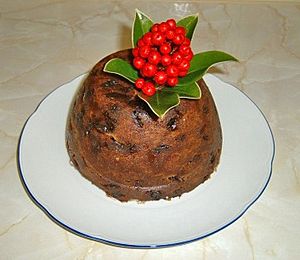Suet pudding facts for kids
| Type | Pudding |
|---|---|
| Place of origin | United Kingdom |
| Main ingredients | Wheat flour and Suet |
| Variations | Spotted dick, Christmas pudding, Treacle pudding, Clootie, Jam Roly-Poly, Paignton, Sussex pond pudding |
A suet pudding is a special kind of pudding from the United Kingdom. It's made using wheat flour and something called suet. Suet is a hard, raw fat that comes from beef or mutton, usually found around the kidneys.
These puddings can be cooked in a few ways: they can be boiled, steamed, or even baked. People often add other yummy things to them, like breadcrumbs, raisins, other dried or preserved fruits, and different spices.
While the word "pudding" often makes us think of a sweet dessert, suet puddings can be either sweet or savoury. Savoury means it's a main dish, not a dessert.
Many types of suet puddings are very famous in British cooking. The recipes can be quite different. Most are boiled or steamed, but some are baked. You might even find recipes for microwave ovens! Sometimes, modern recipes use butter or vegetable shortening instead of suet.
Some well-known sweet suet puddings include spotted dick, Christmas pudding, treacle pudding, clootie, and jam roly-poly. For savoury versions, you might find ones with rabbit, chicken, game meat, or even steak and kidney pudding.
There are also local kinds, like the Sussex pond pudding and the Paignton pudding.
The History of Suet Puddings
Suet puddings have been around for a long time, at least since the early 1700s. An old cookbook from 1714, called A Collection of above Three Hundred Receipts in Cookery, Physick and Surgery by Mary Kettilby, has a recipe for "An excellent Plumb-Pudding." This recipe used a pound of finely chopped suet, along with raisins, flour, sugar, eggs, and a little salt. It was boiled for at least four hours!
Did you know that Christmas pudding actually started as a meat dish? The very first version of suet pudding was a pottage. This was a thick stew of meat and vegetables that came from Roman times. It was cooked slowly in a big pot, and people would add dried fruits, sugar, and spices. By the 1400s, "Plum pottage" was a mix of meat, vegetables, and fruit, often served at the start of a meal.
The name "suet pudding" comes from the special fat, suet, that is mixed with the flour. This fat comes from around the kidneys of animals. In Britain, "pudding" is a general word for steamed dishes, both sweet and savoury. But it can also mean other things, like Yorkshire pudding (which is made from batter) or Bread and butter pudding (a dessert with custard).
Why Suet is Great for Puddings
Suet has a higher melting point than butter. This means it melts at a warmer temperature. Suet melts between 45°C and 50°C (113°F and 122°F). Butter, on the other hand, melts at a cooler temperature, between 32°C and 35°C (90°F to 95°F).
Because suet melts at a higher temperature, it's less likely to melt into the flour when you're making the pastry for the pudding. When the pudding bakes or steams, the suet melts after the pastry has already started to set. This leaves tiny holes in the pastry. This special structure helps the pastry hold up better when it has wet fillings. It also makes the pudding lighter and fluffier!


